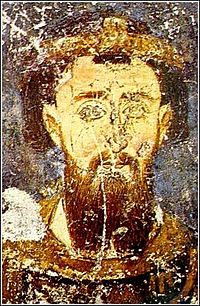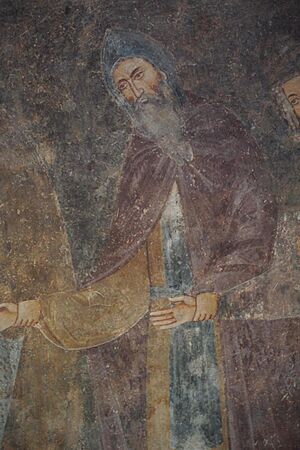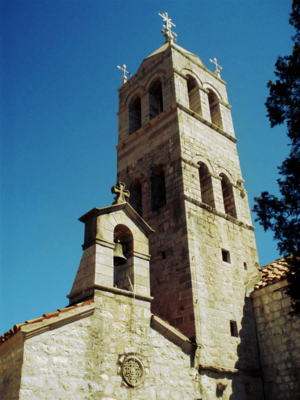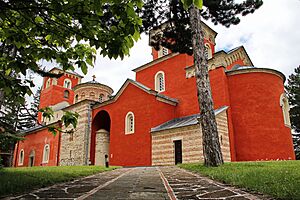Stefan the First-Crowned facts for kids
Quick facts for kids SaintStefan Nemanjić Стефан Немањић |
|
|---|---|

Fresco of Stefan the First-Crowned from Mileševa Monastery
|
|
| Stefan the First-Crowned | |
| Born | around 1165 |
| Died | 24 September 1228 |
| Venerated in | Eastern Orthodox Church |
| Attributes | Church Builder |
Stefan Nemanjić (born around 1165 – died September 24, 1228) was a very important ruler in Serbian history. He was first the Grand Prince of Serbia starting in 1196. Later, in 1217, he became the first King of Serbia and ruled until his death in 1228.
Stefan is also known as Stephen the First-Crowned. He is remembered for turning the Serbian Grand Principality into the Kingdom of Serbia. He also helped his younger brother, Saint Sava, set up the Serbian Orthodox Church. Because of these big changes, he is seen as one of the most important members of the Nemanjić dynasty, a powerful family that ruled Serbia for a long time.
Contents
Early Life and Family
Stefan Nemanjić was the second son of Grand Prince Stefan Nemanja and Anastasija. His older brother, Vukan, was supposed to be the next ruler. Vukan governed the region of Zeta and nearby areas. Stefan's youngest brother was Rastko, who later became famous as Saint Sava. Rastko ruled over Hum.
In 1191, the Byzantine Empire attacked Serbia. Stefan Nemanja, Stefan's father, managed to fight back well. The Byzantine Emperor, Isaac II Angelos, then asked for peace. As part of the peace deal, Stefan Nemanjić married Eudokia Angelina, who was the niece of Emperor Isaac II. Stefan also received a special Byzantine title called sebastokrator.
Becoming Grand Prince
In 1196, Stefan Nemanja decided to step down from the throne. He chose his middle son, Stefan, to become the new Grand Prince of Serbia. This was a bit unusual because his oldest son, Vukan, was expected to take over. Nemanja made Vukan the ruler of Zeta and other regions.
After giving up his power, Stefan Nemanja became a monk and was called Simeon. He then went to Mount Athos in Byzantium, where his youngest son, Sava, was already a monk. Together, they got permission to rebuild the Hilandar monastery, which was very important for Serbian culture and religion.

Challenges and Alliances
After Stefan became Grand Prince, he faced some challenges. His older brother Vukan was not happy about Stefan being chosen as ruler. Vukan teamed up with the Hungarian King Emeric to fight against Stefan. This led to a civil war in Serbia. Around 1200, Stefan even sent away his wife Eudokia, who was a Byzantine princess.
During this time, the Fourth Crusade took place. In 1204, crusaders attacked and conquered Constantinople, the capital of the Byzantine Empire. This changed the political map of the region. Stefan used this chance to get help from Prince Kaloyan and returned to power in 1204. Vukan went back to Zeta. The fighting between the brothers stopped in 1205.
Many new states were formed after the Byzantine Empire weakened. Serbia was located between these new powers: Epirus to the south, Bulgaria to the east, and Hungary to the north and west. Stefan had to be smart about who he allied with.

Stefan also had to deal with issues in other Serbian regions. For example, in Hum, there was a dispute over who should rule. Stefan supported Andrija Mirosavljević and helped him gain control of parts of Hum. He even gave the main rule of Hum to his own son, Radoslav.
Stefan also strengthened his ties with other rulers through marriages. His daughter, Komnena, married Prince Dhimitër Progoni of Albania. This helped create an alliance between Serbia and Albania. Later, Stefan's son, Stefan Radoslav, married Anna Angelina Komnene Doukaina, the daughter of Theodore, the ruler of Epirus. These marriages helped Serbia stay strong in a changing world.
Becoming King and the Church
Stefan wanted to be known as a king, not just a prince. He asked the Pope for a royal crown. In 1217, a special representative from the Pope came to Serbia and crowned Stefan. He was given the title: "Crowned King and Autocrat of all Serbian and coastal lands." This was a huge step for Serbia, making it a recognized kingdom.
However, some Serbian church leaders were not happy about Stefan getting his crown from the Pope. His brother, Sava, even left Serbia for a while to protest. Later, in 1219, Sava became the first head of the independent Serbian Orthodox Church. This made the Serbian Church separate from the Byzantine Church, which was very important for Serbian identity. Some historians believe Stefan might have been crowned a second time by Sava, but most modern experts think the papal coronation was the only one.
Family and Legacy
Stefan Nemanjić was married twice. His first wife was Eudokia Angelina, with whom he had three sons and two daughters:
- King Stefan Radoslav, who ruled after him (1228–1233)
- King Stefan Vladislav I, who ruled later (1233–1243)
- Archbishop Sava II (born Predislav)
- Countess Komnena Nemanjić
His second wife was Anna Dandolo, the granddaughter of a powerful Venetian leader. They had one son and one daughter:
- King Stefan Uroš I, who also ruled later (1243–1276)
Stefan Nemanjić built many important buildings, including the Maglič fortress. Towards the end of his life, like his father, Stefan became a monk and took the name Symeon. He died soon after and was later recognized as a saint.
Local stories say that King Stefan also built the Church of the Dormition of the Mother of God at Reževići Monastery around 1223 or 1226.
Images for kids
In Fiction
- The 2017 TV series Nemanjići - rađanje kraljevine (Nemanjić Dynasty - Birth of a Kingdom) tells his story as the main character.
See also
 In Spanish: Esteban I Nemanjić para niños
In Spanish: Esteban I Nemanjić para niños
- List of Serbian monarchs
- Nemanjić family tree



